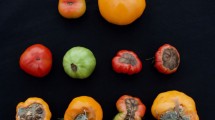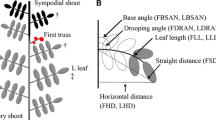Summary
To investigate genetic regulation of blossom-end scar size in tomato (Lycopersicon esculentum Mill.), a half diallel cross including 10 parents was grown under warm fall conditions in Bradenton, Florida, and cool winter conditions in Hazeva, Israel. The parents were a random sample representing all available fresh market tomato breeding lines commercially grown under subtropical field conditions. A randomized, complete block design with three replications was used and the blossom-end scar index (BSI), a measure for scar size relative to truit size, was measured on 40 and 25 fruits per plot in Bradenton and Hazeva, respectively. Analysis of variance for BSI indicated highly significant (P=0.001) variation among parents and among F1's in both environments. In Bradenton and Hazeva both, the difference in average BSI between parents and F1's was not significant suggesting insignificant overall dominance effects. Further partitioning of variation within F1's indicated that general combining ability (GCA) effects were highly significant in both environments, whereas specific combining ability (SCA) effects were significant at P=0.001 in Bradenton, but only at P=0.05 in Hazeva. Estimated variance components for GCA and SCA effects indicated that BSI inherited mainly additively in both environments. Analysis combined over environments indicated that variation in sensitivity to environments was 5-fold higher among parents than among F1's. The genotype x environment variance component was not large enough to justify testing over more than one environment for population improvement purposes and early testing of hybrids. Evaluation of inbred lines, however, may have to be done in more than one environment, especially for ‘Suncoast’-derived material. Under temperatures in Hazeva, genotype differences were more pronounced and heritabilities higher than under high temperatures in Bradenton. The estimated overall single plot heritability was 0.63. Breeding lines with a pointed blossom-end morphology (e.g. NC 8276 and NC 140 in this study) generally had small blossom-end scars, and intercrossing of these lines or crossing with non-pointed, moderately smooth breeding lines generally resulted in smooth hybrids.
Similar content being viewed by others
References
Baker, R.J., 1978. Issues in diallel analysis. Crop Sci. 18: 533–536.
Barksdale, T.H., J.M. Good & L.L. Danielson, 1972. Tomato diseases and their control. USDA Agriculture Handbook No. 203.
Barten, J.H.M., 1991. Genetic, environmental, and physiological factors influencing blossom-end scar size in tomato. Ph.D. Thesis. University of Florida, Gainesville.
Barten, J.H.M., J.W., Scott, N., Kedar & Y., Elkind, 1992. Low temperatures induce rough blossom-end scarring of tomato during early flower development. J. Amer. Soc. Hort. Sci. 117: 298–303.
Barten, J.H.M., J.W. Scott & R.G. Gardner, 1993. Characterization of blossom-end morphology genes in tomato and their usefulness in breeding for smooth blossom-end scars. J. Amer. Soc. Hort. Sci. (Submitted).
Comstock, R.E. & R.H. Moll, 1963. Genotype-environment interactions. In: Statistical Genetics and Plant Breeding, NAS-NRC pub. 982, pp. 164–196.
Dudley, J.W. & R.H., Moll, 1969. Interpretation and use of estimates of heritability and genetic variances in plant breeding. Crop Sci. 9: 257–262.
Eberhart, S.A. & W.A., Russell, 1966. Stability parameters for comparing varieties. Crop Sci. 6: 36–40.
Elkind, Y., O.B., Galper, J.W., Scott & N., Kedar, 1990a. Genotype by environment interaction of tomato blossom-end scar size. Euphytica 50: 91–95.
Elkind, Y., O.B., Galper, S., Vidavski, J.W., Scott & N., Kedar, 1990b. Genetic variation and heritability of blossom-end scar size in tomato. Euphytica 50: 241–248.
Falconer, D.S., 1986. Introduction to quantitative genetics. Second ed. Longman London, pp. 340.
Fortney, W.R., 1958. Genetic and anatomical studies of imperfect stylar scar formation in tomatoes. Ph.D. Thesis. Purdue University.
Gardner, R.G. & A.F., Nash, 1987. Observations on the nipple tip (n) trait and associated characteristics. Report of the Tomato Genetics Cooperative 37: 45.
Griffing, B., 1956. Concept of general and specific combining ability in relation to diallel crossing systems. Aust. J. Biol. Sci. 9: 463–493.
Hanson, C.H., H.F., Robinson & R.E., Comstock, 1956. Biometrical studies of yield in segregating populations of Korean lespedeza. Agronomy J. 48: 268–272.
Miura, H., Y., Shimamoto & C., Tsuda, 1986: Diallel analysis of genotype-environment interaction for phenotypic expressions of a quantitative character in Nicotiana rustica L. Japan. J. Breed. 36: 54–66.
Nash, A.F. & R.G., Gardner, 1988. Heritability of tomato early blight resistance derived from Lycopersicon hirsutum P.I. 126445. J. Amer. Soc. Hort. Sci. 113: 264–268.
Perkins, J.M., 1970. Environmental and genotype-environmental components of variability. VI. Diallel sets of crosses. Heredity 25: 29–40.
Perkins, J.M. & J.L., Jinks, 1968. Environmental and genotype-environmental components of variability. III. Multiple lines and crosses. Heredity 23: 339–356.
Sikes, J. & D.L., Coffey, 1976. Catfacing of tomato fruits as influenced by pruning. HortSci. 11: 26–27.
Wien, H.C. & P.L., Minotti, 1988. Increasing yield of tomatoes with plastic mulch and apex removal. J. Amer. Soc. Hort. Sci. 113: 342–347.
Wien, H.C. & Y., Zhang, 1991. Gibberellic acid foliar sprays show promise as screening tool for tomato fruit catfacing. Hortsci. 26: 583–585.
Wright, A.J., 1985. Diallel designs, analyses, and reference populations. Heredity 54: 307–311.
Young, P.A. & J.W. MacArthur, 1947. Horticultural characters of tomatoes. Texas Agr. Exp. Sta. Bul. 698.
Author information
Authors and Affiliations
Rights and permissions
About this article
Cite this article
Barten, J.H.M., Elkind, Y., Scott, J.W. et al. Diallel analysis over two environments for blossom-end scar size in tomato. Euphytica 65, 229–237 (1992). https://doi.org/10.1007/BF00023087
Received:
Accepted:
Issue Date:
DOI: https://doi.org/10.1007/BF00023087




